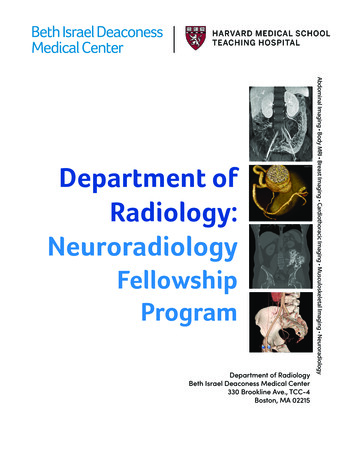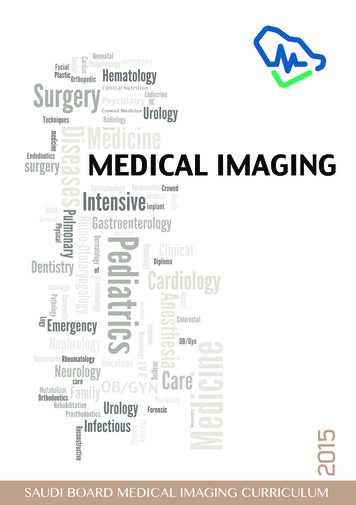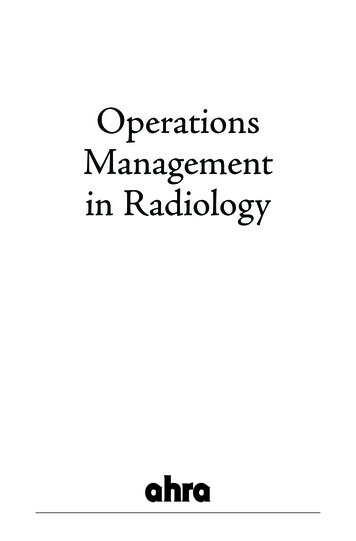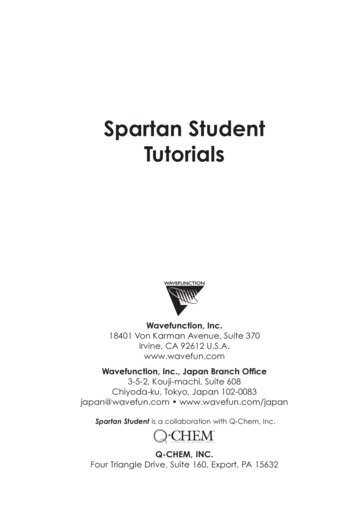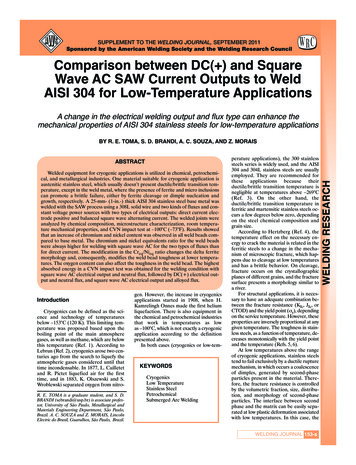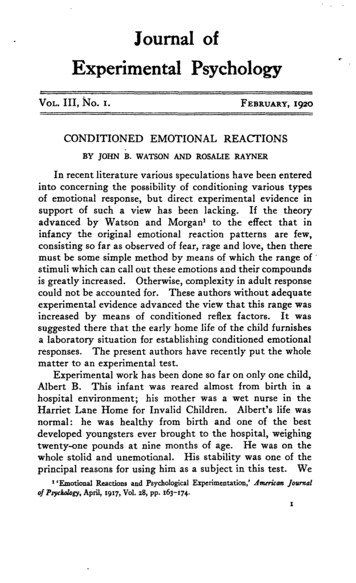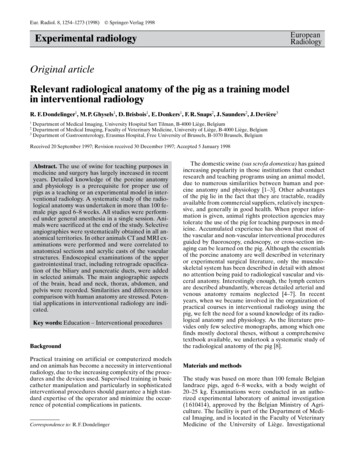
Transcription
Eur. Radiol. 8, 1254 1273 (1998) Ó Springer-Verlag 1998EuropeanRadiologyExperimental radiologyOriginal articleRelevant radiological anatomy of the pig as a training modelin interventional radiologyR. F. Dondelinger1, M. P. Ghysels1, D. Brisbois1, E. Donkers1, F. R. Snaps2, J. Saunders2, J. DevieÁre31Department of Medical Imaging, University Hospital Sart Tilman, B-4000 LieÁge, BelgiumDepartment of Medical Imaging, Faculty of Veterinary Medicine, University of Li ge, B-4000 LieÁge, Belgium3Department of Gastroenterology, Erasmus Hospital, Free University of Brussels, B-1070 Brussels, Belgium2Received 20 September 1997; Revision received 30 December 1997; Accepted 5 January 1998Abstract. The use of swine for teaching purposes inmedicine and surgery has largely increased in recentyears. Detailed knowledge of the porcine anatomyand physiology is a prerequisite for proper use ofpigs as a teaching or an experimental model in interventional radiology. A systematic study of the radiological anatomy was undertaken in more than 100 female pigs aged 6 8 weeks. All studies were performed under general anesthesia in a single session. Animals were sacrificed at the end of the study. Selectiveangiographies were systematically obtained in all anatomical territories. In other animals CT and MRI examinations were performed and were correlated toanatomical sections and acrylic casts of the vascularstructures. Endoscopical examinations of the uppergastrointestinal tract, including retrograde opacification of the biliary and pancreatic ducts, were addedin selected animals. The main angiographic aspectsof the brain, head and neck, thorax, abdomen, andpelvis were recorded. Similarities and differences incomparison with human anatomy are stressed. Potential applications in interventional radiology are indicated.Key words: Education Interventional proceduresBackgroundPractical training on artificial or computerized modelsand on animals has become a necessity in interventionalradiology, due to the increasing complexity of the procedures and the devices used. Supervised training in basiccatheter manipulation and particularly in sophisticatedinterventional procedures should guarantee a high standard expertise of the operator and minimize the occurrence of potential complications in patients.Correspondence to: R. F. DondelingerThe domestic swine (sus scrofa domestica) has gainedincreasing popularity in those institutions that conductresearch and teaching programs using an animal model,due to numerous similarities between human and porcine anatomy and physiology [1 3]. Other advantagesof the pig lie in the fact that they are tractable, readilyavailable from commercial suppliers, relatively inexpensive, and generally in good health. When proper information is given, animal rights protection agencies maytolerate the use of the pig for teaching purposes in medicine. Accumulated experience has shown that most ofthe vascular and non-vascular interventional proceduresguided by fluoroscopy, endoscopy, or cross-section imaging can be learned on the pig. Although the essentialsof the porcine anatomy are well described in veterinaryor experimental surgical literature, only the musculoskeletal system has been described in detail with almostno attention being paid to radiological vascular and visceral anatomy. Interestingly enough, the lymph centersare described abundantly, whereas detailed arterial andvenous anatomy remains neglected [4 7]. In recentyears, when we became involved in the organization ofpractical courses in interventional radiology using thepig, we felt the need for a sound knowledge of its radiological anatomy and physiology. As the literature provides only few selective monographs, among which onefinds mostly doctoral theses, without a comprehensivetextbook available, we undertook a systematic study ofthe radiological anatomy of the pig [8].Materials and methodsThe study was based on more than 100 female Belgianlandrace pigs, aged 6 8 weeks, with a body weight of20 25 kg. Examinations were conducted in an authorized experimental laboratory of animal investigation(1 610414), approved by the Belgian Ministry of Agriculture. The facility is part of the Department of Medical Imaging, and is located in the Faculty of VeterinaryMedicine of the University of Li ge. Investigational
R. F. Dondelinger et al.: Anatomy of the pig as a training model in interventional radiologyprotocols were approved by the local Institutional Ethical Committee. All animals were premedicated by an intramuscular injection of atropine (0.05 mg/kg), midazolam (0.1 mg/kg), and ketamine (20 mg/kg). General anesthesia was induced 15 min after premedication by anintravenous injection of thiopental (5 mg/kg), and maintained with mechanical ventilation and a mixture ofethrane (1.5 2 %) and oxygen (1.5L/min). Althoughtechnically more difficult to perform in the pig compared with other animal species, we prefer artificial ventilation using endotracheal intubation without a tracheostomy, as in experimental studies which requirethe resuscitation of the animal at the end of the procedure. Peripheral venous access was assured by catheterization of the auricular or cephalic vein with a 21-G Teflon-sheathed needle. All angiographic studies were obtained after a closed percutaneous vascular approach,using the right or left femoral arteries or veins andplacement of a 5-F or larger hemostatic valve sheath.The same closed vascular approach is used during allteaching sessions. Usually, access to the vascular systemof the pig is gained by a cutdown of the carotid or femoral artery, and jugular or femoral vein. However, thefemoral artery, and the femoral and jugular veins canalso be punctured by the Seldinger technique using fluoroscopic guidance, bone landmarks, palpation, or ultrasound. The femoral artery should be punctured as itprojects over the lateral edge of the acetabulum withthe pig in a strict supine position having its extendedhindlimbs attached to the table. The needle forms an angle of 35 with the midline. The femoral vein lies 1 cmmedial and runs parallel to the femoral artery. The jugular vein should be punctured at the base of the neck atthe level of the sixth cervical vertebra. Puncture is performed in a medial, caudal direction, with an angle of15 , 4 cm from the midline. In difficult situations aguidewire or catheter can be introduced from the femoral vein, which is easier to puncture, and then placed inthe external jugular vein, serving as a landmark for itspuncture under fluoroscopic control. Closed percutaneous puncture of the carotid artery is not advisable dueto its deep location, its small diameter, and frequentspasm after unsuccessful attempts of catheterization,but it could be punctured in the same way as the jugularvein, with a needle angle of 25 .The angiographic series were acquired with a C arm(Siremobil, Siemens, Erlangen, Germany). The matrixresolution was of 1024 pixels with an acquisition rate oftwo subtracted frames per second. Contrast materialwith a concentration of 300 330 mg iodine per milliliterwas injected either by hand or with an electronic powerinjector. Four- to 5-F catheters and guidewires that arein regular use in human angiography were chosen (pigtail, cobra, sidewinder, headhunter, microcatheters, andothers). Images were recorded and printed with a lasercamera.In addition to angiography, CT and MRI examinations were obtained in selected animals for a better understanding of 3D anatomy. Anesthesia was applied inthe same conditions as those for angiographic studies.The CT technique was performed on a PQ 2000 fourth-1255generation scanner with spiral capability (Picker, Cleveland, Ohio, USA) and MRI on a 1.5-T unit (Magnetom,Siemens, Erlangen, Germany). Three-dimensional reconstructions were obtained on a standard working station (Voxel Q, Picker).Acrylic casts, either of the entire arterial system or ofvarious vascular territories, were obtained in other animals either by a closed or an intraoperative intravascular injection of Flowing Acryl (Bidoul Biolux International, Brussels, Belgium), which rapidly polymerizesafter injection. After sacrifice of the pig, dissolution ofthe skeleton and the viscera was obtained by immersionof the injected specimen in a solution of industrial caustic soda (sodium hydroxide) over a period of 3 weeks.Casts were cleaned of all residual perivascular tissueand skeleton and then mounted and photographed.Fine vascular details showing arteries of 50 to 100 mmin diameter could be demonstrated by this technique.Anatomical sections were prepared on other animalsby producing 1-cm-thick whole-body slices from deepfrozen anatomical specimens in the axial, frontal, andsagittal planes. Sections were photographed and compared with the corresponding CT and MRI slices. Allstudies on the living animal were terminated in one session. Sacrifice of the anesthetized pig was carried out atthe end of all studies by an intravascular injection of a20 % solution of pentobarbital.ResultsIn this condensed report, the most prominent radiological anatomical features that might be of interest to theresearcher and interventional radiologist are highlighted. Anatomical variants are much more frequent in thepig than in humans. We describe the most commonlyfound anatomical findings.Spinal landmarksFor correct orientation during fluoroscopy, the following particulars of the spinal anatomy of the pig, whichdiffer from humans, have to be remembered: the presence of seven cervical vertebrae, 14 15 (extreme values:13 17) thoracic, 6 or 7 lumbar, and 4 sacral vertebrae.The number of thoracic and lumbar vertebrae may thusvary between 19 and 24. The lumbosacral space, between L6 and S1, is particularly large and can be usedfor the administration of epidural anesthetics. The spinal cord ends at the level of the first or second sacralsegment in the young animal and more cranially at thelevel of L6 in adults. The pig has approximately 20 caudal vertebrae, the last 15 forming the curved tail.The headThe reduced volume of the brain contrasts with the development of the facial anatomy as in other animal species. The large communicating maxillary, frontal, lacry-
12561R. F. Dondelinger et al.: Anatomy of the pig as a training model in interventional radiology32Fig. 1. Arteriography of the bicarotid trunk, anteroposterior projection: the ascending pharyngeal artery (1) originates as a small sidebranch from the common carotid artery (2) and feeds the carotidrete mirabile (3) on each side of the hypophysis. Note the well-developed external carotid artery (4), internal maxillary artery (6), lingualartery (7), and fine basilar artery (5), opacified in a retrograde wayFig. 2. Arteriography of the common carotid artery, lateral projection: the rete mirabile (asterisk) is fed by the ascending pharyngealartery (3). Note the common carotid artery (1), external carotid artery (2), occipital artery (4), lingual artery (5), facial artery (6), auricular artery (7), internal maxillary artery (8), buccal artery (9), palatine artery (10), and infraorbital artery (11)Fig. 3. Acrylic cast of the carotid rete mirabile, anterior view: ascending pharyngeal artery (1), junction of both rete mirabilia onthe midline (star)Fig. 4. Acrylic cast of the rete mirabile, lateral view: ascending pharyngeal artery (1), rete mirabile (asterisk), intracerebral carotid artery (2), posterior communicating artery (3), circle of Willis (4)Fig. 5. Arteriography of the left vertebral artery, anteroposteriorprojection: numerous-branch arteries feed the soft tissues of theneck (large open arrow). The vertebral arteries supply the basilar artery (arrow), which is connected to the rete mirabile (asterisk) andgives off the ventral spinal artery (arrowheads). Both vertebral arteries connect through metameric spinal arteries (small open arrows)54mal, sphenoid, and conchal sinuses are particularlystriking. The arterial vascularization of the cephalic extremity is characterized by the discrepancy between theexternal carotid and cerebral artery territories. Thecommon carotid artery has a diameter of 5 6 mm andgives off as a small sidebranch the ascending pharyngealartery, which is the equivalent of the internal carotid artery in humans (Fig. 1). The external carotid artery is incontinuity with the common carotid artery and shows asimilar caliber. It gives off the lingual artery, the externalmaxillary artery, the auricular (magna) artery, the superficial temporal artery, the transverse facial artery, the internal maxillary artery, and branches to the parotidgland. The large internal maxillary artery gives rise tothe medial meningeal artery, the deep temporal artery,the mandibular artery, the buccinator artery, the external ophthalmic artery, the malar artery, the nasal artery,the palatine artery, and the infraorbital artery (Fig. 2).The arteries anastomose through the midline with theiropposite homonymous counterparts. Numerous arteriesbranch into an intense arteriolar territory, irrigating thewell-developed olfactory system, whereas the other ar-
R. F. Dondelinger et al.: Anatomy of the pig as a training model in interventional radiologyteries mainly supply the masticator muscles and the tongue. In contrast, the ascending pharyngeal artery has adiameter of less than 3 mm at the base of the skull. Atthat level the ascending pharyngeal artery divides intotiny infrabasal arteries. These arteries continue throughthe foramen lacerum and anastomose in an epiduralrete mirabile that grossly measures 1 2 cm in diameterand is composed of a fine arteriolar ovoid-shaped structure. The medial meningeal artery and the nasal arteryare also connected to the rete mirabile. This plexiformnetwork contains interconnected microarteries 50 250 mm (Figs. 3, 4). The vascular configuration of therete strongly resembles the gross morphology of a highflow vascular malformation with a feeding vessel, whichis the ascending pharyngeal artery, a nidus representedby the rete itself, and high-flow draining vessels whichare the intracerebral arteries. Both rete are connectedthrough the midline extending on either side of the hypophysis and medioventrally to the maxillary nerve inthe large cavernous sinus. The cephalic extremity ofthe epidural rete extends into the cerebral internal carotid artery which, after perforating the dura mater,gives the nasal artery and a caudal communicating artery which anastomoses with the basilar artery. The circle of Willis also gives off fine cerebral arteries which irrigate the brain. The rete prevents any catheterizationof the intracerebral arterial territory in the pig. Therete mirabile can be used for creation of a high-flow arteriovenous malformation and for the testing of smallcaliber embolization material in high-flow conditions[9 11]. The physiological role of the rete is not completely understood. It may have a flow damping effecton the intracerebral circulation [12]. The rete mirabileexists in other mammalian species as well, but is notfound in human anatomy. The brain of the pig is irrigated anteriorly by the carotid system and posteriorly by athin vertebral supply. The posterior intracerebral contribution of the equivalent of the circle of Willis, fed byboth vertebral arteries, is minor, also rendering any intracerebral catheterization unpracticable from this approach (Fig. 5).The intracerebral circulation is connected with extracerebral arteries through the internal ophtalmic arteries. The rete is also connected with the extracerebralarteries through the anastomic artery (external ophtalmic artery) and the ramus anastomicus (middle meningeal artery).The neckAnatomy of the neck is relevant with regard to surgicalcarotid artery dissection, percutaneous venous puncture, and endotracheal or endoesophageal intubation.The neck of the pig is relatively long compared withhuman anatomy. However, rotation of the cervical spineremains limited and no forced movements should be applied during manipulation of the animal.Both common carotid arteries show a diameter of5 6 mm and originate together through a short commonbicarotid trunk from the brachiocephalic artery, which is1257the largest branch of the thoracic aortic arch (Figs. 6, 7).The common carotid artery is surrounded dorsomedially by the vagal sympathetic nerve trunk, and ventrallyby the recurrent nerve. It gives the distal laryngeal artery, the occipital artery that communicates with thevertebral artery, a caudal meningeal artery, the superiorthyroid artery, and branches to the trachea and theesophagus. The carotid artery can be catheterized easilywith a 4- or 5-F cobra, headhunter, or multipurposecatheter by a femoral approach. It can serve for stentplacement in mid-sized arteries, but the carotid arteryof the pig is particularly prone to spasm during PTA orstent placement. Direct closed percutaneous catheterization is not feasible due to its deep location in theneck, lateral to the sternomastoideus muscle. Therefore,a surgical cutdown is preferable. Occlusion of the bicarotid trunk should be avoided during a retrograde approach when large hemostatic valve sheaths have to beadvanced from either carotid artery into the thoracicaorta.All veins draining the blood from the head and neckend in the 1-cm-long common jugular vein, which receives the internal and external jugular vein on eachside. Jugular veins show typical valves, which maymake catheterization more difficult than in humans(Fig. 8). The external jugular vein drains the bloodfrom the face and neck through the linguofacial andmaxillary vein. Venous puncture at the neck is basedon different landmarks than those in humans. The internal jugular vein is not accessible for percutaneous catheterization because of its deeper position and small caliber. The external jugular vein has a larger diameter andmerges with the internal jugular vein and the axillaryveins at the level of the first rib, ending in a large venousconfluence. The right external jugular vein is preferredfor puncture, since it allows a straight catheterizationof the cranial and caudal venae cavae and their tributaryveins (Fig. 9). Injury to the phrenic nerve and thoracicduct during venous puncture are minimized when theprocedure is performed on the right side.The nasopharynx shows a distinct feature in that itterminates with a posterior pharyngeal diverticulum.This cul-de-sac is situated between the ventral straightmuscle of the head and the origin of the esophagus. Ithas to be recognized in order to avoid perforation intothe prevertebral soft tissue during forceful esophagealintubation. Esophageal tube placement should alwaysbe a smooth procedure, without resistance. The esophagus is used for training in stent placement. Regular sizesof stents are applicable.The larynx of the pig is remarkable for its length andmobility, as the cartilagenous rings are elongated craniocaudally and loosely attached to each other. The hyoid and thyroid cartilages are long and compressed laterally. The epiglottis is large and closely connectedwith the hyoid bone. A middle ventricle is present nearthe base of the epiglottis. The free extremity of the epiglottis extends ventrally to the palate which explains thedifficulties in tracheal intubation (Fig. 10). Furthermore,the larynx forms an obtuse angle with the trachea. Bothof these anatomical features, the position of the epiglot-
1258R. F. Dondelinger et al.: Anatomy of the pig as a training model in interventional radiology678a8b10Fig. 6. Arteriography of the thoracic aorta, anteroposterior projection: note the strong brachiocephalic artery (1), which divides intothe right subclavian artery (2) and the short bicarotid trunk (3),which gives rise to both common carotid arteries (4). Note the leftsubclavian artery (5) originating from the aortic arch, the internalthoracic artery (6), the external thoracic artery (7), and the finevertebral artery (arrowheads)Fig. 7. Acrylic cast of the thoracic aorta and its branches, anteriorview: thoracic aorta (1); brachiocephalic artery (2); right subclavian artery (3); common bicarotid trunk (4); common carotid artery(5); left subclavian artery (6); internal thoracic artery (7); vertebralartery (8). Note the rich arteriolar network of the cervical andscapular region9Fig. 8 a, b. Occlusive phlebography of the veins of the neck: a nonsubtracted image; b subtracted image, anteroposterior projection.The external jugular vein (1) results from the confluence of the linguofacial and maxillary veins. It joins with both axillary veins (2),cranial vena cava (3). Note the endoluminal valves (arrowheads)Fig. 9. Acrylic cast of the mediastinal vessels, right lateral view.The veins are colored in gray and the arteries in red: right atrium(1); caudal vena cava (2); cranial vena cava (3); azygos vein (4); brachiocephalic artery (5); left subclavian artery (6); thoracic aorta (7)Fig. 10. Sagittal anatomical section passing through the larynx: epiglottis (thin arrow); nasopharynx (star); cricoid cartilage (arrowhead); muscles of the tongue (asterisk); palate (thick arrow)
R. F. Dondelinger et al.: Anatomy of the pig as a training model in interventional radiology1259tis, and the laryngotracheal angle make endotrachealtube placement particularly cumbersome in the pig.Moreover, the mobile larynx can easily be pushed caudally over several centimeters with the tube; this movement should not be confused with successful cannulation of the trachea. Any forceful manipulation shouldbe avoided.We therefore recommend placing the animal in a lateral decubitus position. A 35-cm-long, semirigid, 8-mmcuffed endotracheal tube is advanced into the larynx.When the extremity of the tube abuts against the cricoidring, the tube is withdrawn a few centimeters, rotatedthrough 180 dorsally and gently advanced during expiration. The tube has a tendency to preferentially enterthe esophagus rather than the trachea. Usually, severalattempts are required before tracheal intubation isachieved. The tube is then rotated back to its originalposition. Placing the cervical spine in hyperextensionand using fluoroscopic control may facilitate the procedure.The thoraxThe thoracic cage is rounded and limited by the dorsalspine, 14 15 (more broadly, 13 17) strongly curved pairsof ribs and the sternum. The first seven ribs connect directly to the sternum. The total number of ribs may beasymmetrical. The diaphragm closes the thorax caudallyand projects at the level of the eight thoracic vertebra.The cranial mediastinum extends against the anteriorarch of the left ribs.We describe the pulmonary anatomy, the heart, andthe coronary arteries.The bronchial treeThe trachea has a length of 15 20 cm, contains 32 45rings, and has a circular diameter of 10 13 mm. Its division into a right and left main bronchus projects at thelevel of the fifth thoracic vertebra in the decubitus position. For the description of the bronchial anatomy weadopted the recent classification given by Nakakuki[13]. Four groups of bronchioles originate from themain bronchus on each side and are classified as dorsal,lateral, ventral, and medial. They all branch from themain bronchus (Fig. 11). The bronchioles from the lateral group are the longest; the distal bronchioles (L6) or(L7) are shorter than the proximal ones (L1). The lobesof the right lung are designated as the cranial, middle,caudal, and accessory lobe, and the lobes of the leftlung include the bilobed middle and the caudal lobe. Atracheal bronchus arises from the right side of the trachea, proximal to the tracheal bifurcation and ventilatesthe right cranial lobe. It corresponds to the right craniallobe bronchiole III of the mammalian bronchial tree.The middle lobe is ventilated by the first bronchiole ofthe lateral group (L1) and arises from the ventrolateralside of the right main bronchus. The accessory lobe isventilated by the first bronchiole of the ventral groupFig. 11. Acrylic cast of the tracheobronchial system, anterior view:trachea (1); right tracheal bronchus (2); first bronchiole (L1) of theright lateral group (3); first bronchiole (V1) of the ventral group orbronchus of the right accessory lobe (4); first bronchiole (L1) ofthe left lateral system (5); alveolar cast of the left cranial lobe (6)(V1). This lobe is situated between the base of the heartand the diaphragm and entirely surrounds the terminalintrathoracic portion of the caudal vena cava. The caudal lobe is the most developed and is ventilated by thedorsal bronchiole group (D2 D6), the lateral (L2 L6),the ventral (V2 V5) and the medial system which hasonly one bronchus (M4). A deep cardiac notch separates the cranial lobe from the middle lobe and an incomplete fissure the middle lobe from the caudal lobe.The left lung has no cranial lobe and no tracheal bronchus. The left middle lobe is formed by the first bronchiole of the lateral system (L1) which divides into a cranial and a caudal branch. Similarities can be found withthe left upper lobe bronchus in humans which dividesinto a culminal and a lingular branch. The left caudallobe is formed by the lateral (L2 L6), dorsal (D2 D7),ventral (V2 V5), and two middle bronchioles (M4 andM5). An incomplete fissure separates both lobes.The bronchial tree is mainly used for training in tracheobronchial metal stent placement. The regular adultstent sizes are applicable.Pulmonary arteries and veinsThe pulmonary artery divides into a right and leftbranch which runs along the dorsolateral side of eachmain bronchus. Side branches come off similarly to thebronchioles over the whole length of each pulmonaryterritory and run mainly along the dorsolateral side ofeach bronchiole (Fig. 12). Accessory pulmonary arteriesmay occur. The pulmonary arteries have a relatively re-
1260aR. F. Dondelinger et al.: Anatomy of the pig as a training model in interventional radiologybabFig. 12 a, b. Arteriography of the pulmonary circulation. a Arterial phase; b venous phase, anteroposterior projection: commonpulmonary artery (1); right pulmonary artery (2); left pulmonaryartery (3); pulmonary artery of the right cranial lobe (4); pulmonary artery of the right accessory lobe (5); right lateral branches(6); caudal lobe pulmonary venous trunk (7); right cranial (8) andright middle lobe vein (9); left atrium (10); thoracic aorta (11)Fig. 13 a, b. Arteriography of the esobronchial trunk. a Non-subtracted image; b subtracted image, anteroposterior projection:the origin of the esobronchial artery projects at the level of theleft tracheobronchial angle (asterisk). Note the bronchial arteriesrunning parallel to the wall of the main bronchi (arrowheads) andthe fine esophageal branches (arrows). A tortuous bronchial arteryis present in the right accessory lobe (open arrow)sistant wall and are easily catheterized up to their periphery. They can be used for exercising selective catheterization, embolization techniques with macrocoils ordetachable balloons, catheter thrombectomy, etc. Dueto the straight course of the pulmonary artery, withoutdichotomic divisions, foreign body retrieval from theperiphery of the lung is easy to perform. During experimental studies, proximal occlusion of the pulmonary arteries usually does not produce parenchymal infarctionbecause of the considerable hypervascularization thatis rapidly provided by the pulmonary-bronchial arteryanastomoses [14].The pulmonary venous drainage is as follows: lateral(from L2 downwards), dorsal, ventral and middle veinsfrom the caudal lobe converge to a large caudal lobepulmonary venous trunk on each side. The right accessory lobe vein reaches the right caudal lobe pulmonaryvenous trunk. On the right side there is in addition atrunk of the right cranial lobe vein and a right middlelobe vein (L1) that converge and enter the left atrium.On the left side, there is a trunk of the middle lobe veinwhich enters the left atrium. Pulmonary veins mainlyrun along the medial or ventral side of each bronchiole.Their distribution pattern is variable.Under normal circumstances, bronchial arterioles regularly anastomose with the pulmonary arteries at the microscopic level. Branches of the celiac artery anastomose indirectly through the esophageal wall vascularization with the bronchial arteries. The bronchoesophageal arterial trunk is best catheterized with a 4-F Simmons-I or cobra-type catheter by a femoral approach.A retrograde carotid approach is more cumbersome.Transcatheter embolization using 50 150 mm particlescan be used for training in the bronchial arterial systemwith a microcatheter, but the stable position of the catheter at the aortic ostium may be difficult to maintain.Bronchial arteriesThe pig typically presents a common arterial bronchoesophageal trunk with a diameter between 1 and 2 mm,which arises from the anterior aspect of the descendingthoracic aorta at the level of the left tracheobronchialangle. Each bronchial artery runs along the lateral sideof the main bronchus and irrigates a rich peribronchialarterial network (Fig. 13) [14]. When bronchial arteriography is performed, a dense enhancement of the wall ofthe main bronchus is seen in the capillary phase, whichreflects the intense bronchial arteriolar vascularization.Heart and coronary arteriesAdult pigs have a smaller heart size to body weight ratiothan any other domestic animal (0.3 %). However, inyounger pigs, which are commonly used in the laboratory, the ratio is identical to that of humans. The heart ofthe pig has the form of a blunt cone which extendsfrom the second to the fifth rib and lies left of the midline (Fig. 14). It is embedded within the cardiac notchof both lungs. The heart shows a right and a left atrium,auricle, and ventricle. The heart is separated from thediaphragm by the right accessory pulmonary lobe. Thecaudal vena cava has a 4- to 5-cm-long intrathoracic segment which is surrounded by lung parenchyma (Fig. 15).The right ventricle follows the course of the sternum.
practical courses in interventional radiology using the pig, we felt the need for a sound knowledge of its radio-logical anatomy and physiology. As the literature pro-vides only few selective monographs, among which one finds mostly doctoral theses, without a comprehensive textbo


